Naval Base Ventura County Leading the Way with LED Lighting
As the designated “Energy Showcase Base” for the West Coast, Naval Base Ventura County’s (NBVC) charter is to install and test “new and emerging” and “state of the shelf” technologies and to share results with the rest of the Navy. As a result, NBVC is one of the first naval installations to install LED exterior and interior lighting. LED exterior fixtures have been installed at both Port Hueneme and Point Mugu sites in roadway, parking lot, building exterior security and gas station canopy applications. The majority of this new lighting has been installed in areas with the highest evening/night presence (i.e. family housing, bachelor quarters, shopping/dining, entertainment), where enhanced lighting provides the most benefit to base personnel.
NBVC Port Hueneme and Point Mugu sites are located in Ventura County on California’s Gold Coast, located 60 miles north of Los Angeles. A third site consists of San Nicolas Island, which is 60 miles off the coast of Point Mugu. NBVC is a major aviation shore command and Naval Construction force mobilization base providing airfield, seaport and base support services to fleet operating forces and shore activities. The base employs 20,060 personnel (including military, civilian and contractor) and includes more than 90 military commands (17 major and 12 deployable) with diverse mission operations in support of the Department of Defense (DoD). NBVC’s missions include combat and weapon systems testing on the 36,000 square mile Sea Range off the coast of Point Mugu.
Since LED lighting is currently considered new and emerging technology, many manufacturers are producing inferior products with the aim of obtaining a share of the growing market. This has resulted in some inefficient products that under-perform and often fail in advance of their rated life. This makes choosing quality LED products at the early stages of development a challenge. When selecting LED products for installation at NBVC, specific criteria and specifications had to be met. Some of these criteria include: thermal management (how well a light fixture dissipates heat from internal components), optical control (how well a fixture distributes light to surfaces to be illuminated), color rendition (how well the light renders colors of objects illuminated), quality of LED and electrical components, long-life and fixture aesthetics.
When selecting color temperature of new exterior fixture LED modules, NBVC specified LEDs in the range of 5,000 to 6,000 degrees Kelvin – the “blue” range of the color spectrum. LED modules in their natural state are mostly manufactured in a blue color, their most efficient state. In order to get “warmer” colored LED modules, LED manufacturers add phosphor coatings to the chips to produce a warmer colored light, which also decreases the lumen output of the chips. NBVC has adopted the concept of “spectrally enhanced” (scotopic) lighting. This works on the premise that the human eye sees more acutely under bluer light, such that the human eye perceives spaces lit with bluer light as being “brighter” than what the actual (physical) illumination levels are.
The various types/applications of LED lighting installed at NBVC are included below.
Exterior LED Lighting Installations
1. Roadways – Approximately 460 existing 250-watt (total energy consumption of 300-watts), high-pressure sodium (HPS) cobra head roadway fixtures were replaced with 150-watt LED fixtures in residential and resident support (shopping/
dining/entertainment) areas at Port Hueneme and Point Mugu.
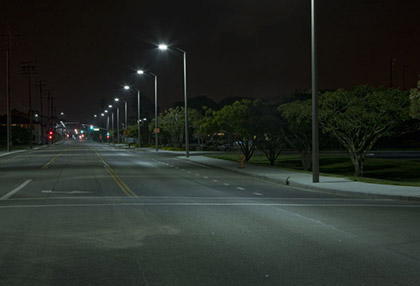
Photo Credit: Naval Base Venture County
Besides a reduction of 50 percent energy consumption, the new fixtures immediately transformed these areas from low color-rendering orange/yellow light to high quality, glare-free, friendly “white” light, which renders colors more accurately.
The majority of comments received from base residents have been positive. However, a handful of residents thought the new lights were “too bright,” resulting from white light appearing brighter than the previous yellow light even though the new lights consume half the energy of the old HPS fixtures. People generally feel more secure under “white light” as opposed to “yellow light” because of better visibility. It should be noted that these projects only replaced light fixtures on existing poles. No new poles were added nor existing poles relocated to change fixture spacing.
2. Parking Lots – Between Port Hueneme and Point Mugu, a total of seven parking lots have been retrofitted with new LED light fixtures. Roughly 132 existing HID (high intensity discharge, consisting of metal halide and HPS) sharp cutoff “shoebox” light fixtures were replaced with 86-watt “shoebox” style LED fixtures. The majority of fixtures replaced were 250-watt HPS, which when replaced with the new 86-watt LED fixtures resulted in a 77 percent energy savings. Additionally, the new LED fixtures either met or exceeded minimum footcandle levels while drastically reducing energy consumption. In one case, 400-watt HPS sharp cutoff luminaires were replaced with the 86-watt LED fixture with remarkable results. This parking lot was over lit to begin with, so replacing existing fixtures with new lower wattage LED fixtures brought illumination levels to proper light levels.
3. Port Hueneme NEX/Commissary – This complex was included as part of a Technical Evaluation (Techval) lighting study performed in 2010 by the Naval Facilities Engineering Service Center (NFESC), a tenant command at Port Hueneme. This study entailed testing LED and induction (an incumbent fluorescent technology) lighting side-by-side in the NEX/Commissary parking lot. Existing 400-watt HPS sharp cutoff fixtures were replaced with 200-watt induction fixtures on the Commissary side of the parking lot and 207-watt LED fixtures on the NEX side. A portion of this study compared illumination pattern profiles between LED and induction systems to determine which system was more desirable. Results of this study showed illumination levels directly under induction fixtures were extremely high and illumination levels tapered off quickly as one moved away from the induction fixtures.
This resulted in small pools of extremely bright light directly under fixtures and dark spaces between fixtures. This poses a safety and security hazard to motorists and pedestrians using this lot.
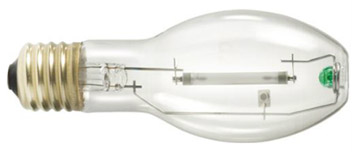
Courtesy Photo: Philips
The main reasons for this type of light distribution are the large size and diffuse nature of the induction lamp, which is hard to control. On the other hand, illumination from LED fixtures was evenly distributed across the parking lot surface directly below and between fixtures. This eliminated bright and dark areas, thus increasing safety and a sense of security for motorist and pedestrian. LED fixtures consist of an array of individual LEDs and optics that precisely aims the light of each individual LED at a different angle to achieve an evenly distributed light pattern.
After this study was completed, the induction light fixtures on the Commissary side of the parking lot were replaced with LED fixtures to match those installed on NEX side of the lot, thus resulting in the entire lot being evenly illuminated at proper levels. The new LED light fixtures have reduced energy consumption by roughly 55 percent from the previous HID fixtures. The new fixtures were fitted with an onboard occupancy sensor, which turns the fixture off when no movement is detected in fixture vicinity. Yet, it immediately turns the light on when movement is detected, thus saving additional energy during late night and early morning hours.
4. NEX Gas Station Canopy – Existing metal halide light fixtures under gas pump canopies at both Port Hueneme and Point Mugu gas stations were replaced with new LED fixtures, resulting in an 83 percent energy savings compared to the previous system. The old metal halide fixtures were deteriorated, extremely dirty and contained old, lumen depreciated lamps, which reduced light output. The new fixtures greatly enhanced illumination at these two locations by providing bright “white,” high quality, evenly distributed light that provides a better sense of security to patrons using these facilities after dark. Since both of these facilities are 24/7 operations, the long life of these fixtures will greatly reduce the number of disruptions to gas station operations due to frequent maintenance requirements of the old metal halide system.
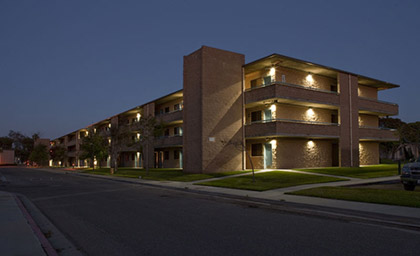
Photo Credit: Naval Base Venture County
5. Bachelor Quarters Area Lighting – A total of 549 existing 50-watt and 70-watt HPS wall pack light fixtures were replaced with new 35-watt LED wall packs around the perimeters of multi-story bachelor housing facilities at both Port Hueneme and Point Mugu sites. Old HPS wall pack fixtures, which directed the light out and downward, resulted in glare and austere yellow light to building occupants and personnel passing by these facilities. New LED wall pack fixtures direct all light downward with no direct glare to building occupants. Installation of these new fixtures has dramatically transformed the nighttime appearance of these facilities, thus making them more attractive and friendly. Many of the multi-story facilities at Port Hueneme are constructed of split-face concrete block that results in rough exterior wall surfaces. The downward “grazing” nature of the new fixtures highlights the texture of these walls and creates a dramatic appearance.
To further reduce energy consumption, the NBVC Energy Team collaborated with a fixture manufacturer to add an onboard occupancy sensor component to the LED wall pack fixture. This sensor allows the fixture to ramp down to a lower light output, resulting in lower energy usage during periods of time when building occupants are not present. Once the onboard sensor senses movement of a person walking by, the fixture immediately ramps the light level back to full output, allowing the person to safely navigate the walkway. During late night and early morning hours when all residents are in their rooms, all exterior lights remain at low light levels (10-watts compared to 35-watts), which further reduces energy consumption. One by-product of this feature is that security personnel will be able to pinpoint pedestrian traffic around these buildings easily since movement will ramp the lights up to full brightness, acting as a visual cue to Security alerting them that a person is currently walking around that area.
Interior LED Lighting Installation
As LED lighting begins transitioning to interior applications, NBVC decided to install new LED fixtures in one facility at Port Hueneme. Existing 175-watt metal halide recessed downlight fixtures were removed and replaced with two-foot by two-foot 54-watt LED lay-in fixtures on a one-for-one basis in a 21-foot high ceiling of building entry lobby.
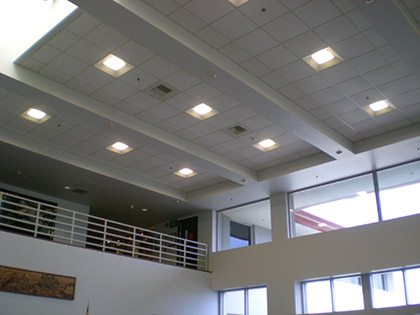
Photo Credit: Naval Base Venture County
The new lights are instant-on, provide a 75 percent energy savings compared to the old metal halide lighting system and have greatly enhanced the quality and quantity of lighting in this space. Since the lobby receives adequate daylighting from a north-facing window wall and skylights at the south end of lobby, the new lights are controlled via photosensors, which turn the lights on and off depending on the quantity of available daylight into the space. This type of control was not feasible with the old metal halide system since there was a warm-up period required by the old system as opposed to the instant-on ability of LED lighting. Maintenance costs will also be considerably less with the much longer life of the LED fixture.
Future of LED Lighting
At this point in time, LED technology for the general lighting world is still in its infancy and shows great promise to revolutionize the lighting industry as we know it. LED technology has made great strides the past few years in terms of efficiency (lumens per watt), LED module life and fixture component quality (actual LED chips, thermal management, driver, etc.). The one drawback plaguing this technology is product pricing. LED fixtures are currently two to four times more expensive than incumbent technologies, including fluorescent and high-intensity discharge (HID) fixtures. However, as production becomes more efficient and can compete with the cost of incumbent technologies, LED fixtures will become more popular due to their low energy use, long-life, improved light quality and instant-on capabilities. The demand for this technology will bring other manufacturers into the marketplace and product prices will drop. This is already beginning to happen. However, with the recent advances in technology, the public still needs to be aware of inferior, underperforming products in the marketplace.
One application that is receiving much development in the field of LED lighting is general interior lighting fixtures for commercial and industrial installations. Many LED manufacturers are currently promoting LED tubes in a T8 fluorescent lamp configuration that can replace an existing fluorescent tube in existing fluorescent fixtures. At this point in time, this type of retrofit is not very effective since these tubes contain rows of LEDs focused in one direction only, making them very inefficient in existing fluorescent fixtures. Many fluorescent lamp manufacturers are competing with this T8 LED product by offering lamps with extended lamp life in the 30,000 to 40,000 hour range, which competes with the lamp life of the T8 LED tubes.
My strategy for NBVC is to ignore the LED retrofit T8 tubes and wait for a complete light fixture designed specifically around the LED that will incorporate optics to maximize the light distribution of the LED. These fixtures are now being developed by fixture manufacturers and are resulting in efficient, architecturally appealing designs. Pricing on these fixtures as compared to their fluorescent counterparts is still on the high-side, but the gap is slowly diminishing.
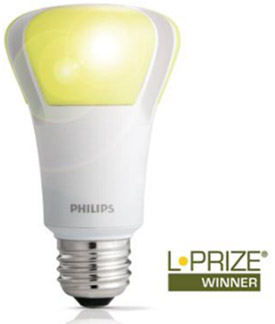
Courtesy Photo: Philips
Lastly, the Department of Energy (DOE) is pushing to develop and market LED replacement lamps for the incandescent and compact fluorescent lamp. DOE has recently awarded the
“L-Prize” for an LED equivalent of the 60-watt incandescent A19 lamp, which will be available in the near future (2012). The first offering of this lamp will be expensive, but as time goes by the price will drop. This lamp shows great promise of an energy efficient, long-life, maintenance-free replacement to everyone’s favorite lamp. Other wattage lamps and configurations are also in development, which will greatly increase alternative lamp offerings for residential and commercial use. Another requirement for the L-Prize replacement lamp for the 60-watt A19 incandescent is that it must be dimmable; this will also greatly increase its use in residential applications.
In conclusion, LED lighting has proven a viable, energy-efficient, sustainable technology that has shown great promise for exterior and interior uses within Naval Base Ventura County and other military installations. This new, exciting technology holds great promise and potential to revolutionize the lighting industry in terms of lighting products that are very energy-efficient, have an extremely long-life and provide high-quality, instant-on, user-friendly “white” light. Once this technology becomes widely accepted and price competitive with incumbent lighting products, some of the incumbent products, such as incandescent, compact fluorescent and some HID sources, will become obsolete and disappear altogether.
These lighting projects were administered through the Naval Base Ventura County Energy Program. The NBVC Energy Team’s responsibility includes promoting energy conservation and awareness within the NBVC community as well as initiating and managing energy projects (including photovoltaics, solar thermal, wind, mechanical, water and lighting), which are implemented on NBVC’s three sites. Since 2001, NBVC has received seven Platinum level Secretary of the Navy (SECNAV) Energy and Water Management Awards and two Federal Energy Management Program (FEMP) Water Management Awards. In 2008, NBVC received the SECNAV Large Shore Energy and Water Management Award




























